| Reviews & Columns |
|
Reviews DVD TV on DVD Blu-ray 4K UHD International DVDs In Theaters Reviews by Studio Video Games Features Collector Series DVDs Easter Egg Database Interviews DVD Talk Radio Feature Articles Columns Anime Talk DVD Savant Horror DVDs The M.O.D. Squad Art House HD Talk Silent DVD
|
DVD Talk Forum |
|
|
| Resources |
|
DVD Price Search Customer Service #'s RCE Info Links |
|
Columns
|
|
|
Come Have Coffee with Us (Venga a Prendere Un Caffe Da Noi)
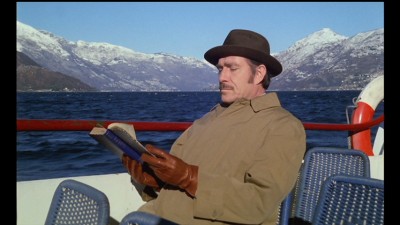
"I thank God I was raised Catholic, so sex will always be dirty." - John Waters
Alberto Lattuada's 1970 film Come Have Coffee with Us (Venga a Prendere il Caffè... da Noi) has many of the trappings of a silly, vulgar, throwaway sex comedy, but it has something a bit more sinister on its mind than just that. Its slight, harmless appearance hides some provocative moral and aesthetic questions that are ultimately imposed on the audience, who--if they came just for the cheap laughs and trashy titillation that the film actually does offer, at least initially--will find themselves made progressively uncomfortable, until by the end any complacent desire for low-grade, exploitative escapism has been cruelly frustrated and turned back on itself by the film's relentless, increasingly garish excess, which reaches a near-punitive pitch by the time it arrives at its harshly satirical ending.
In a provincial Italian town, three virginal middle-aged sister spinsters of the haute bourgeoisie--French tutor Fortunata (Angela Goodwin); church librarian Tarsilla (Francesca Romana Coluzzi); and harp-playing ultra-neurotic Camilla (Milena Vukotic)--are left bereaved and laden with a valuable estate and fortune when their father, a prominent lawyer and part-time naturalist/botanist, keels over dead in his greenhouse, having suffered a stroke evidently brought on by his excitement when finding or creating, in his gene-spliced plant mutations, the extreme point in Nature where beauty and ugliness become indistinguishable. The three wealthy sisters are of suddenly increased interest to the townspeople, despite their plainness and eccentricity, and taking particular note of the situation is the ambitious, calculating war veteran and tax inspector Emerenziano (Ugo Tognazzi), who swoops in to see which sister he might ensnare most easily in order to become the new, baron-like proprietor of the walled and gated upper-class abode that seems to both literally and figuratively look down upon the rest of the town.
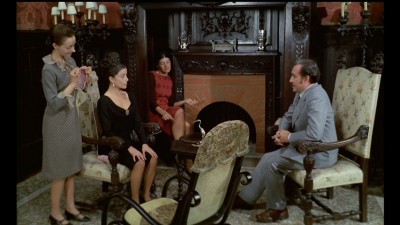
Emerenziano needn't have worried about the effort of convincing the three ladies, who are comically depicted as running over with repressed, salacious sexual desire. Much is made of the wellsprings of lusty excitement latent in their devout Catholicism; Lattuada and his co-screenwriters milk many an irresistible laugh from Tarsilla in particular, who chides young female library patrons looking for sex manuals (merely offering them one prefaced with a letter from the Pope) even as she sneaks aroused peeks at a copy of The Story of O hidden in her desk drawer, and who readily gives in to the ardent attentions of sexy good-for-nothing Paolino (Jean-Jacques Fourgeaud), which runs its vigorously fornicating course in the parish's abandoned, dusty storeroom among discarded confessionals and holy objects, Tarsilla's orgasmic energy evidently deriving as much from the taboo-smashing blasphemy of it all as from her and Paolino's wild lovemaking.
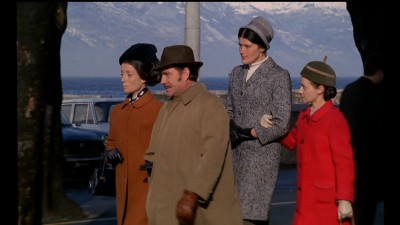
Emerenziano finally chooses the eldest, Fortunata, as his betrothed after paying several calls to the house for coffee and reconnaissance--rendez-vous for which the entire household (including the maid) has primped itself into a state of what it feels is maximal seductiveness. But once Emerenziano has married Fortunata and moved in, and after his wife's age and inexperience have put a damper on the physical aspect of their honeymoon period, he takes both Tarsilla and Camilla as mistresses, paying them regular 1:15 a.m. visits on alternating days (except, hilariously, Sunday), all of which the observant maid records in her personal calendar. These upper-crust libertines eventually become an inseparable foursome, their unbridled gratification of appetite culminating in a grotesque scene in which they gorge themselves on food and drink at their finely laid-out dinner table. But Emerenziano's reach exceeds his grasp when he attempts to bring the maid into his stable, too, and he meets the same overexcited fate as his wife's and mistress' father--except he survives to live in perpetual conjugal indulgence at the hands of the three sisters, whom we last see practically force-feeding him an ice cream cone that he demanded but can't quite get down (they never learn, do they?).
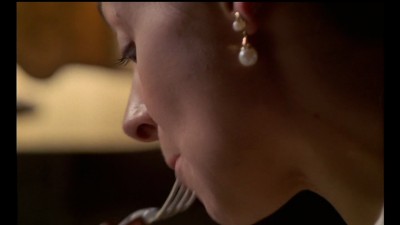
Lattuada stages everything cartoonishly; every color and performance is exaggerated, while Fred Bongusto's score and a recurring trashy pop song add a taunting, carnivalesque air that becomes positively rancid as the film goes on. Lattuada rapidly and disjointedly edits the scenes of indulgence--sexual or gastronomical--for a harried, vertiginous, overstuffed and nauseated effect, leaving us feeling as overfull yet dissatisfied as children the morning after Halloween. This becomes fatiguing, but that's part of Lattuada's strategy; for all its unpleasantness and misanthropy, Come Have Coffee with Us effectively makes its point about the sick-making ill-advisedness of actually grabbing after everything you want with no limits and pursuing pleasure to the point where beauty and ugliness blur together (with the additional implication that anything beautiful becomes ugly when one loses perspective by overdosing on it). It's a point that has also been made, in more elegant ways yet with similar aesthetic approaches, by films like Pasolini's Salò, Peter Greenaway's The Cook, the Thief, His Wife, and Her Lover, and Mary Harron's American Psycho, but Lattuada's rotted-from-the-inside style does so with such unremitting gleefulness (which extends to a degree the aforementioned films stop well short of, however much more graphically sexual or violent they are) that it is, as intended, simply hard to take. It is as if, in the process of learning its quite successfully conveyed moral and aesthetic lessons, one is not only reminded of the physical and mental dangers of gluttony, but also cured at the same time of any need to revisit such a convincingly nasty piece of work anytime too soon.
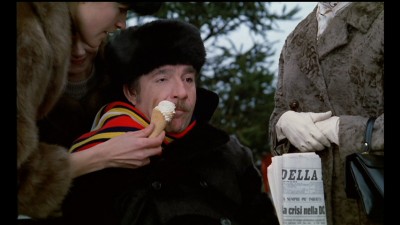
THE DVD:
As far as the content of the image goes, the transfer is free of a single blemish; all the bad-dream, Technicolor-garish colors are too-bright and too-vivid (as intended), and all the shadows and light come through splendidly. The one minor noticeable oddity (I would not even go so far as to call it a flaw) is that, in bringing us the film at the correct 1.66:1 aspect ratio, the transfer seems to slightly clip the image at the top of the frame for some reason, which is unusual for the 1.66:1 format. That does not diminish the visual impact of the film in any way, however, and after initially remarking it, it became virtually unnoticeable.
Sound:The disc's Dolby Digital 2.0 soundtrack is also practically perfect, presenting the film's nicely restored original sound design (including, as always for pre-late-'70s Italian cinema, post-dubbed audio) as clearly and richly as one imagines would ever be possible, without a single instance of distortion, crackle, imbalance, or other audio flaws due to print age or wear.
Extras:--A 15-minute interview with film historian and Italian film expert Adriano Aprà, who offers some nice insights into the film and its meaning(s), as well as its place in Lattuada's filmography and in the Italian cinema. Had I been the interviewer, I might have tried for a bit more discussion of the film's specific social, political, and historical contexts for the benefit of those non-Italians who may not perceive all such nuances, but it's still an eye-opener.
--A long-form essay by Aprà on Lattuada and his work comprises the bulk of the usual in-depth booklet RaroVideo puts together for each of their releases; it also includes an array of critical perspectives from the film's release and its later revivals on Come Have Coffee with Us as well as a brief biography of Lattuado and a complete chronological listing of his films.
FINAL THOUGHTS:Recommended. A cautionary tale that shows you the downside of self-indulgent excess by confronting you with the initially "fun," ultimately nauseating cinematic equivalent of the same, Come Have Coffee with Us is a gaudy, memorably unpleasant cinematic fable that has zero interest in being liked and every intention of overwhelming and repelling us with its too-muchness. At that it is an inarguable success, and the experience is worthwhile as a provocation, reminder, and example of undeniably effective aesthetic strategies for driving home the point. Whether this exercise comes across as interesting and rueful-smile-inducing or just spitefully disgusting is subjective; though I could understand having either impression of the film, my own response tended toward the former to a degree that I feel I can endorse it out of appreciation for the admirable aptness of its style and its undeniable (if utterly unsavory) power.
|
| Popular Reviews |
| Sponsored Links |
|
|
| Sponsored Links |
|
|
| Release List | Reviews | Shop | Newsletter | Forum | DVD Giveaways | Blu-Ray | Advertise |
|
Copyright 2024 DVDTalk.com All Rights Reserved. Legal Info, Privacy Policy, Terms of Use,
Manage Preferences,
Your Privacy Choices | |||||||












